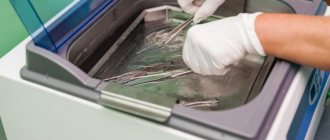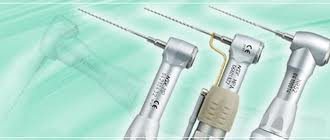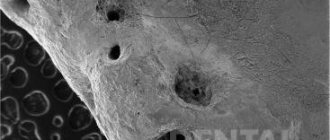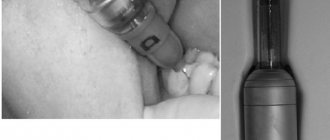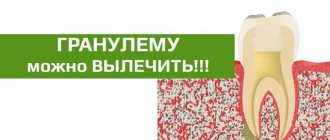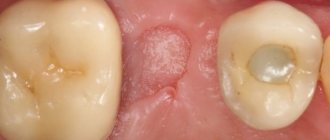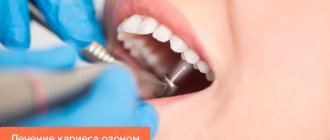Indications, methods and features of tooth removal
Doing everything to preserve the patient’s own tooth is the basic principle of all qualified dentists. If this is not possible, removal and subsequent prosthetics are indicated. Both during treatment and before installing certain types of prostheses, depulpation is often resorted to.
What it is? This is the process of removing the neurovascular bundle, the soft structure that fills the cavity of the coronal part and canals of the root system. That is, the nerve, also called the pulp.
When is depulpation justified?
If the problem tooth has a filling or deep caries has previously been removed, the pulp must be damaged. Grinding under a crown can cause additional difficulties; the likelihood of developing necrosis increases; the depulpation procedure is fully justified.
When the carious cavity is large, the pulp interacts with bacteria, and the formation of replacement dentin begins. Dentinal tubules become obliterated, and the impact of external negative factors increases.
Tooth preparation can also cause problems. The likelihood of thermal or physical damage to the pulp is reduced. The likelihood of a successful operation is reduced. Denticles can form in the tooth due to problems with processing and enlargement of obliterated canals.
Indications for depulpation
Nerve depulpation is carried out in two cases: when the neurovascular bundle is already inflamed or when there is a risk of damage and inflammation. Why is this being done? To avoid complications, since pulpitis can lead to serious consequences: periodontitis, periostitis, cysts and root granulomas, etc.
Therefore, indications for its removal are generally represented by the following situations:
- pulpitis directly, that is, inflammation of the nerve pulp, when conservative or medicinal treatment is not possible,
- trauma - root fracture, mechanical damage to the bone tissue of the jaw, etc.,
- exposure of the pulp as a result of chipping,
- deep caries, when again it is better to remove the dental nerve than to treat it,
- periodontitis,
- during dental prosthetics, that is, in preparation for the installation of a prosthesis.
The final decision to remove the pulp is made by the doctor, taking into account the condition of the teeth, prognosis for the course of diseases, age, and structural features of the entire dental system.
It is worth noting that depulpation before prosthetics is a controversial issue. Some dentists note that preserving the nerves will ensure a longer life of the supporting teeth, since deprivation of nutrition leads to rapid destruction. Others insist on preliminary removal - the fact is that the supporting teeth when installing bridges or single crowns are subject to grinding. In order to avoid unpleasant sensations after fixing the structure, as well as to prevent such unpleasant consequences as burns of the pulp, its trauma during grinding, and nerves are removed. In addition, if the nerve remains under the crown, there is a high probability of its damage - then the prosthesis will have to be removed, treated, and a new crown made (it will no longer be possible to install the old one).
The final decision (to remove or leave the nerve) remains between the patient and the dentist - this issue should be discussed individually.
How is the procedure performed?
You don’t need to immediately prepare yourself for the fact that it will be very painful for you when the nerves are removed. Today this is done using modern painkillers.
If in the old days the nerve was removed using arsenic, which was in the oral cavity for at least a week, today this manipulation can be performed in just one visit to the dentist.
How it's done:
- the doctor injects a local anesthetic and after it takes effect, the canal will be cleaned and expanded;
- then the doctor treats the oral cavity with an antiseptic to avoid infection;
- The nerve is removed using special equipment;
- The doctor uses an antiseptic again and seals the canal.
If there are any problems, the specialist may perform the manipulation a little differently. After treating the canals, a professional puts a special substance into the cavity, the effects of which are similar to those of arsenic, but the harm from it is much less.
After the nerve is eliminated, the doctor will install a temporary filling and perform a secondary cleaning to remove necrotic areas. You may have to walk around with the temporary filling and the medication underneath for some time. And only after the specialist is completely convinced that the outbreak has been eliminated, he will install a filling on a permanent basis.
After the intervention, the tooth may be sensitive and even painful for several days. If swelling appears and the temperature rises, this is a serious reason to consult a doctor. To calm down, you need to do an X-ray examination and take painkillers prescribed by your doctor.
Contraindications to the procedure
Removal of the neurovascular bundle is contraindicated in a patient in a state of acute malaise caused by: ARVI, infectious diseases, inflammatory processes. The procedure will also have to be postponed in the first and third trimesters of pregnancy.
Absolute contraindications are acute leukemia, cardiovascular diseases, hemorrhagic diathesis, infectious hepatitis, neurological disorders and mental illness.
It is worth noting that the structure of the root system canals can also be an obstacle to pulp removal. Too thin, curved canals make it difficult to effectively remove the beam, make it impossible or extremely difficult to carry out endodontic treatment (treatment and filling), so the doctor may recommend a different method of treatment due to the high risk of error. In particular, the removal of the entire tooth.
Why is this necessary?
Until recently, depulpation was performed every time before implantation. Today, more and more specialists believe that such procedures are appropriate in rare situations when the positive effect outweighs the bad results.
Depulpation is carried out for preventive purposes. With pulpitis, internal tissues with capillaries and nerve tissues can become inflamed. The probability of developing such a disorder exceeds 60% if the prosthetic procedure was carried out with errors. Another cause of the inflammatory process is the opening of the dental canal. To ensure that the infection has nowhere to spread, depulpation is carried out.
The main indicators for pulp removal:
- Fragmentary exposure of nerve tissue.
- Radical caries, damage to the root near the nerve.
- Incorrect location of dentitis.
- The chewing surface or other tooth fragments are heavily worn.
- Inflammatory processes in the tissues that fix the tooth.
- Mechanical damage to dentitis, increasing the likelihood of death of nerve tissue.
When, after placing the implant, inflammation begins or the pulp festers, the doctor will be able to remove the prosthesis for further treatment to determine the provoking factors. Such implants cannot be reused, so you will have to turn to dental technicians again to create another implant, which will cost you money.
Some clinics offer people a discount, but it does not apply to the procedure for re-prosthetics, so doctors often recommend removing nerve tissue before prosthetics.
Stages of nerve removal
The question “how is tooth depulpation done” is asked by many who are undergoing this procedure. Let's tell you more about the procedure:
- preparation: diagnostics - examination, tapping, x-ray - this is necessary in order to make a diagnosis, evaluate the structure of the canals, depth and width, the presence or absence of curvatures,
- anesthesia: the choice of anesthetic is determined by the individual characteristics of the patient - effective anesthesia will prevent discomfort and pain during manipulations. On the upper jaw, conventional infiltration anesthesia is used, on the lower jaw, as a rule, conduction anesthesia is used,
- removal of tissues softened by caries (if any): the doctor removes part of the crown and provides access to the root canals. All this is done using a drill,
- pulp removal: using special instruments, nerves are removed from the canals,
- canal treatment: rinsing with antiseptic solutions is performed. Next, using dental instruments, the doctor processes the canals - widens them, makes the walls smooth, after treatment they are dried with a stream of air,
- filling: the doctor fills the root canals with special material and evaluates the work using a control x-ray.
In most cases, this is followed by the installation of a temporary filling - this is necessary for further monitoring of the condition, assessing the quality of filling the canals and eliminating inflammation. If there are no complaints, the dentist will place a permanent filling or prosthesis at the next visit.
Important! As a rule, treatment of pulpitis is carried out in 2 visits - this allows you to evaluate the quality of cleaning of the dental canals and exclude re-infection.
Dental depulpation techniques
Before starting treatment procedures, the dentist studies the history of the disease, taking into account the patient’s age. The clinical picture of the onset and process of the disease, disorders present in the periodontium and other factors are considered. As a result, he chooses the depulpation technique. In dentistry, there are two methods of performing surgery: devital and vital.
With the devital technique, the nerve ending of the tooth is killed in advance; this is done using a paste specially designed for this procedure. The pulp chamber is opened, treated with paste, and then tightly closed and left for several days.
This is done so that the pulp loses sensitivity and does not react to various irritants. The operation under such conditions is almost painless. This method is used in case of difficult patency of the root canals of the tooth.
On this topic
- Depulpation
What are the consequences of removing a dental nerve?
- Olga Alexandrovna Novikova
- August 15, 2020
With the vital technique, the pulp is treated using anesthetic drugs. They “muffle” the pulp’s reaction to changes, and it is immediately removed. With this method, the treatment time is much shorter.
In practice, doctors often use a permanent filling. However, this method will not immediately detect a complication. It is more effective to use temporary filling. Then the dentist can see how successful the treatment is. And also to know for sure that after depulpation the tooth is in optimal condition.
Methods for removing a nerve bundle
How long does it take to depulp a tooth? The answer to this question depends on the method. In certain cases, preliminary “killing” of the nerve is recommended, in others the process is performed faster, in one visit.
Vital extirpation
This method involves no preparation - the pulp is not exposed, it is removed “alive”. The method is helpful in cases where it is possible to partially preserve the pulp. The price in this case is lower compared to the non-vital method.
“There was a need to remove the nerve - the tooth had imperceptibly decayed, the caries was deep, the doctor advised not to risk it and depulpate it, because most likely the inflammation had already gone deeper. She did not insist on using arsenic - she asked for good local anesthesia. I felt absolutely nothing, the nerves were removed quickly and painlessly. And there was no need to go to the doctor additionally - everything was done in two visits.”
Natalya, review from the site irecommend.ru
Devital extirpation
Preliminary “killing” is carried out in order to facilitate extraction of the nerve. For this purpose, depulping pastes (arsenic or arsenic-free, formaldehyde-based) are used, as well as electrochemical action. This is an additional stage, which slightly increases the treatment time, but guarantees the absence of unpleasant sensations and consequences.
This is interesting! Many experts argue about the advisability of using arsenic-containing pastes due to the fact that the constituent substance is a dangerous poison. However, it has been proven that ultra-precise dosing and retention of the product in the tooth cavity allows the procedure to be performed without health hazards. Arsenic acid compounds are the most reliable and fastest way.
Whitening of pulpless teeth
The color restoration procedure is called endobleaching. In this case, a lightening component is introduced into the tooth. The procedure is very effective and absolutely painless.
Indications:
- giving a darkened tooth a light shade;
- damage with hemorrhage;
- filling with dyes;
- staining of dentin due to the penetration of dyes through cracks. These substances are things that people consume every day: tea, coffee, nicotine.
The doctor will carefully examine the condition of the oral cavity. After establishing the true cause that contributed to the darkening, the sharp filling is removed and the coloring agent is removed. Special sealing gaskets are placed at the mouths of the canals to prevent the penetration of bleaching agents. A special bleach is injected into the resulting cavity and a filling is installed for two weeks.
At the next visit, the filling and substance are removed and, if necessary, the manipulation is repeated. Restoration is carried out using special materials. The next whitening may be needed in a year or more.
How painful is depulpation?
The possibilities of modern dentistry virtually eliminate pain during nerve removal. In order to prevent discomfort, the dentist uses the latest generation anesthetics - Ubistezin, Ultracain, Scandonest, etc.
There are often situations when a tooth hurts after depulpation - unpleasant sensations appear after the end of anesthesia and can persist for some time.
How long does a tooth hurt after depulpation? Normally, pain can persist for about 4-5 days. Increased sensitivity of the tooth after depulpation may also occur for some time. But in order to understand whether this is a natural reaction to the intervention or a symptom of a complication, it is worth paying attention not only to the duration of the pain, but also to its nature: it should not increase, on the contrary, the sensations weaken every day. The negative consequences of the procedure can also be determined by other symptoms – we’ll talk about this later.
Possible complications and consequences
Severe and persistent pain after depulpation may be a sign of a violation of the technology of endodontic treatment: leaving part of the pulp in the canals and further development of inflammation, underfilling of the canals, which leads to the proliferation of bacteria in the cavity, excessive filling - removal of material beyond the root apex, which provokes reactions of the periodontal tissues . It is necessary to determine the true cause together with a doctor by contacting him again.
If the cheek is swollen after tooth depulpation, severe sensitivity to temperatures, swelling and redness of the gums appear, this also indicates serious complications: leaving a fragment of an instrument, root perforation (artificial creation of a hole), soft tissue injury, allergic reaction to filling materials, insufficient antiseptic treatment and further inflammatory process.
A natural consequence is sometimes a change in the color of the enamel. That is why depulpation of the front teeth is often associated with a cosmetic defect: the enamel may darken or acquire a grayish tint. This is a correctable defect: you can contact your dentist and find out whether endodontic whitening of one tooth is possible. Or you can get veneers.
Some patients do not want to remove the nerves, believing that after this the tooth will soon collapse. The service life depends on several factors: the professionalism of the doctor, compliance with endodontic treatment technology, tooth restoration or installation of a prosthesis, and further care.
Important! Removing a nerve actually entails a change in metabolic processes. Fragility can be caused by a lack of important elements supplied by the blood. But high-quality restoration using modern materials can significantly extend the service life - from 10 years or more.
How to eliminate pain?
If pain occurs only when you tap on the tooth, then there is only one way out - stop touching it and see a dentist as quickly as possible.
If the pain syndrome is so severe that it prevents you from eating normally, then simple manipulations will help eliminate it.
The first step is to take an analgesic. It will relieve pain for a while. After which you should direct all your efforts to stop the development of inflammatory processes.
To prevent inflammatory processes, you can rinse your mouth:
- soda solution (1 tsp per glass of warm water);
- furatsilin solution (1 tablet per glass of warm water);
- infusion of chamomile or calendula (1 tablespoon of herb per glass of boiling water, leave for 30 minutes).
Soda solution and furatsilin solution prevent the addition of bacterial and fungal infections (with inflammation, local immunity is reduced, as a result of which pathogenic microflora appears in the gum pockets, favorable for the development of pathogenic bacteria).
And herbal infusions help relieve inflammatory processes.
